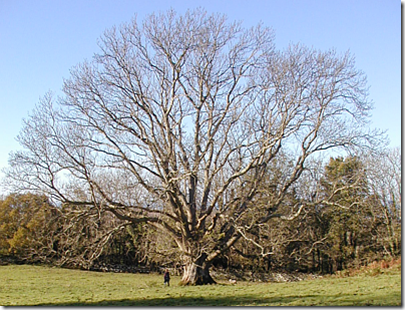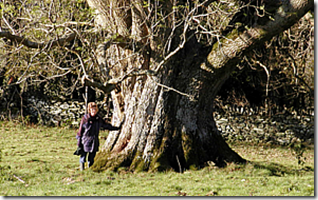 We are lucky, perhaps even honoured. We own an ash tree, and it’s rather a special one as the picture shows. The small figure to the left of the trunk is my wife, and she’s of average height. This is a very, very large ash tree indeed, and of course that also means that it is very, very old.
We are lucky, perhaps even honoured. We own an ash tree, and it’s rather a special one as the picture shows. The small figure to the left of the trunk is my wife, and she’s of average height. This is a very, very large ash tree indeed, and of course that also means that it is very, very old.
Our land includes about 17 acres of wood, mainly oak but with some ash and too much sycamore, but this tree isn’t part of one of the woods. It’s a lone sentinel in a pasture (the Welsh term is parc) and that means this tree really gets noticed. Of all its neighbours on our land, this is the individual that stands out from the rest, and it would be missed far more than any of the others should something happen to it.
With Ash Dieback Disease (Chalara fraxine ) firmly established in the UK’s woodlands and forests – and in the headlines too for the moment at least – we’ve been thinking about this tree quite a lot. It’s not just its visibility as it towers above all competitors, and the impact if it falls victim to this terrible disease, but also what it tells us about the world we live in, and how it has changed during the tree’s lifetime
 Throwing a tape measure round the trunk the other morning, I discovered that it had a girth of 21ft 7ins. When I returned to the house, I counted off annular rings on some ash logs in the woodshed against a six-inch rule. This showed that their width varied a great deal, but even so, it was possible to estimate that the tree’s age must be at least three hundred years, and quite possibly six hundred years or even more.
Throwing a tape measure round the trunk the other morning, I discovered that it had a girth of 21ft 7ins. When I returned to the house, I counted off annular rings on some ash logs in the woodshed against a six-inch rule. This showed that their width varied a great deal, but even so, it was possible to estimate that the tree’s age must be at least three hundred years, and quite possibly six hundred years or even more.
Of course a tree this old, growing in quite an exposed position, will have suffered serious damage from time to time. The westerly gales can be vicious here. Looking at its structure, it seems that it may have lost its crown at least once, with new branches growing from the surviving bowl about ten feet from the ground. In fact after a heavy gale there are often a few fallen branches lying beneath it that make a welcome contribution to the woodshed. On occasions they have been almost the size of an ordinary full-grown tree, but this specimen is on such a vast scale that the damage has not been noticeable.
When I pass the tree, which I often do as it is near a footpath that leads to the village, there are two literary allusions that come to mind. The first is a quotatioin from Keat’s Hyperion:
As when, upon a tranced summer-night,
Those green-rob’d senators of mighty woods,
Tall oaks, branch-charmed by the earnest stars,
Dream, and so dream all night without a stir,
Save from one gradual solitary gust
Which comes upon the silence, and dies off,
As if the ebbing air had but one wave;
OK, so he is talking about oak trees, but the magic of his words applies equally to great ash or elm trees as well.
Normally I don’t do anthropomorphism of any kind, finding television nature programmes about polar bears called Cedric or wild geese called Mavis quite unwatchable, but in the case of these ‘senators’ it doesn’t seem to matter. A tree can certainly have a personality and a character that are recognisable, and that impression in no way diminishes ones appreciation of its place in the natural world. On a summer evening, ‘green robed senator’ certainly seems to do justice to the longevity and dignity of such a vast specimen.
Which leads on to something far more bizarre. W.H. Hudson, the British domiciled South American naturalist, records the following anecdote in his autobiography, Far Away and Long Ago:
One of the most treasured memories of an old lady friend of mine, recently deceased, was of her visits, some sixty years or more ago, to a great country-house where she met many of the distinguished people of that time, and of her host, who was then old, the head of an ancient and distinguished family, and of his reverential feeling for his trees. His greatest pleasure was to sit out of doors of an evening in sight of the grand old trees in his park, and before going in he would walk round to visit them, one by one, and resting his hand on the bark he would whisper a goodnight. He was convinced, he confided to his young guest, who often accompanied him in these evening walks, that they had intelligent souls and knew and encouraged his devotion.
Never in my life have I patted a tree – let alone hugged one – and I hope that I’m not yet as eccentric as that long-gone English squire, but I think I can at least understand how he felt. A tree of great age and size undoubtedly has a presence that transcends the mundane, even if there are few who would claim that it has an intelligent soul. More than that, I find joy in knowing that someone could feel that way about the mighty trees that were his companions.
This evening, the Met Office is forecasting another hard blow, but nothing out of the ordinary for late November. In the morning, when it gets light, I will undoubtedly look out across the fields to reassure myself that an old friend has survived the night, but that moment will be blighted by impending tragedy now.
From what I have seen about Ash Dieback Disease in the media, this problem was at first spun as an affliction that had suddenly been detected in a few nurseries in East Anglia. There were hopes that it could be contained. Then it emerged that It was well known that ninety per cent of Denmark’s ash trees had been wiped out as the pestilence swept across Europe. Concern that the pathogens could spread up to 20 kilometres on the wind was disturbing, but also seemed to rule out airborne transmission to our island nation. The shortest sea crossing to the continent is nearly double that.
Later we were told that infected seedlings were imported from our European partners, and though the risk had been recognised up to four years ago, EU regulations made banning imports rather difficult and slow, so it never happened. Now it seems that there are dying ash tree all over the country, including North Wales, although I haven’t had the heart to find out how near to us. Next year, these infected trees will spread their malady still further, and no one holds out much hope of avoiding a holocaust on the Danish scale. But as anyone will know who has travelled in that rather bleak and windswept country, the impact on our landscape will be far greater.
As an Island nation, all this could so easily have been prevented.
Our ash tree may have been a sapling when Henry V led his troops into battle against the French at Agincourt, in an age when even the English spoke a language we would find hard to understand. As a virile young Henry VIII – the son of a Welshman – strutted to the throne, it would have been a fine mature tree already of good size. By the time Guy Fawkes planned his nasty little surprise for parliament, after the turbulent age of the Tudors had run its course, the tree would have been decidedly stately. A century later, the Act of Union with Scotland, and the arrival of Hanoverian monarchs on our shores would have come and gone, as would Napoleon’s retreat from Moscow after yet another hundred years, matters remote from an agricultural community in Wales, yet important in their own way. And then at the beginning of the twentieth century this tress was spared when much of Wales’ mature timber was felled to shore up trenches in Flanders. And now, it seems, this mighty ash will fall victim not to old age, or a great storm of wind tearing in from the Irish Sea one winter night, but to political negligence and the complete incompetence of nameless bureaucratic.
However permanent our great ash tree might look and vitality, strength – and stability are still written into every line of is vast trunk and spreading branches – it is not proof against human folly and indifference to the condition of the countryside and the natural world.

Magnificent tree, shouts its age. It does nothing to soften the effects of bureaucratic incompetence, but just perhaps, given the age of your splendid specimen, it carries sufficient different genes to resist the onslaught.
miket,
I’d wondered about that too. It must be a pretty robust specimen to have lasted so well, or has it just been lucky?
That’s an amazing size for an ash tree. They are usually relatively short-lived I think. Have you considered reporting it to the Woodland Trust’s ancient tree survey? We also have three fairly large ash trees in our garden, though nowhere near as big as this one.
The ash disease has been around in Europe for many years. Why were the Government, journalists and environmental activists so slow to notice it? I think we all know the answer to that question.
Paul
Unfortunately the Woodland Trust is not popular in this area at the moment: see here They’d probably send along a man with a chainsaw having first obtained a large chunk of Govt/EU funding.
If the answer to your question is that they were all far too busy trying to convince themselves and us that humans now control the weather to bother about such trivia as a preventable disease that may devastate our landscape, then I agree.